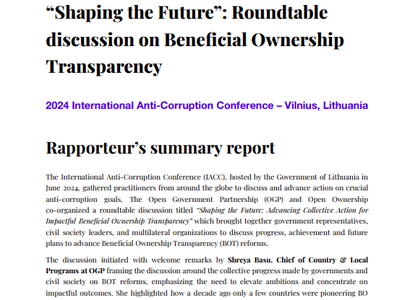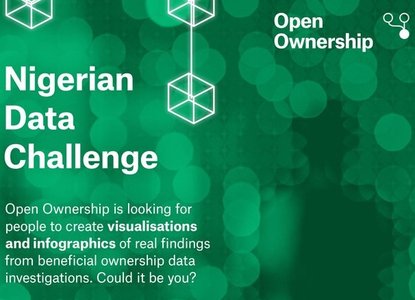Beneficial ownership transparency and the fight against grand corruption in Nigeria

Introduction
Over recent years, Nigeria has made significant strides towards combating illicit financial flows through the use of beneficial ownership transparency. The past few years have seen legislative reforms and concrete efforts by the Nigerian government to put systems in place to implement these.
New research from the Global Integrity Anti-Corruption Evidence Programme (GI-ACE) examines whether and how beneficial ownership transparency in Nigeria can help prevent grand corruption and money laundering. It concludes that Nigeria needs to intensify its efforts in two broad areas: firstly, the use, sharing, access, management, and cleaning of beneficial ownership data; and secondly, the strengthening of intergovernmental coordination among key agencies to advance beneficial ownership transparency reforms.
Nigeria’s low threshold: A compliance burden?
In a summary of the research paper, principal investigator Professor Jackie Harvey discussed the impact of certain policy choices made by Nigeria, such as the decision to use a relatively low threshold of 5%. Countries such as the United Kingdom and United States of America currently use a 25% disclosure threshold. The summary rightly highlighted that the low threshold may create a large pool of beneficial owners and a “greater burden” on the Corporate Affairs Commission (CAC) to deliver on its mandate. In addition, the summary asserted that the large pool of disclosing entities would increase transaction costs and make the Nigerian market unattractive to genuine investors. Whilst we recognise these concerns, this analysis neglects important positive impacts that arise from effective implementation of beneficial ownership transparency.
Concerns about compliance burden and increased transaction costs are often mooted as negatively affecting small and medium sized enterprises, which form the bulk of businesses in Nigeria. However, these small and medium sized businesses are likely to have simpler beneficial ownership structures and are least likely to be affected by a lower threshold. For example, the new Companies and Allied Matter Act 2020 allows small companies (companies earning not more than NGN 25,000,000 turnover per year) to have only one shareholder, thus making it easier to have a simple ownership structure.
Using a lower threshold can also generate more useful data. Open Ownership (OO)’s analysis of Nigeria’s initial extractives beneficial ownership disclosures in 2020 showed just how much data is lost when a higher threshold is used: almost half of beneficial owners that had been disclosed using a 5% threshold would not appear if a 25% threshold had been used. Especially in a high-risk sector such as extractives, this additional information has clear benefits to enabling actors like investors to understand how ownership and control is operating in order to inform investment decisions and mitigate corruption risks.
Rolling out implementation
The administrative challenges that the 5% threshold creates for the CACare indeed significant, with over three million companies falling in scope of the beneficial ownership regulations. With technical assistance from OO, Nigeria is implementing new software that aims to make data collection swift and effective. The new system uses online submission and a database structure compatible with the Beneficial Ownership Data Standard.
Rolling this out across all sectors of the economy is a large undertaking, and perhaps the CAC’s burden could have been somewhat alleviated by using a phased approach to implementation, or a risk-based approach to the thresholds. These approaches are recommended in the Open Ownership Principles for Effective Beneficial Ownership Disclosure, and are successfully implemented in countries such as Ghana. The disclosure threshold for Ghana is 5% for high-risk sectors such as extractives, banking, insurance, and gaming, among others, and 20% for companies in all other sectors. With the aim of balancing reporting burden and granular detail for high-risk individuals, Ghana’s regime applies a 5% disclosure threshold for foreign politically exposed persons (PEPs) and a 0% threshold for local PEPs.
Countries such as Armenia have phased their implementation, beginning with high-risk sectors first and subsequently extending to companies in other sectors. This approach allows the implementing agency to prioritise its resources on high-risk sectors and test out new software and data collection approaches prior to extending them to companies in other sectors.
By opting to implement beneficial ownership transparency with the 5% threshold across the whole economy, the CAC has set itself an ambitious goal with less space to test and iterate. However, there are many reasons to be optimistic. Sponsored by a multi-donor grant, the CAC is currently developing a full economy beneficial ownership register and is actively pursuing cross-government collaboration in relation to data sharing and verification. For example, the CAC is in talks with the National Identity Management Commission to agree on the mechanisms for verifying the data and identity of beneficial owners.
Evidently, Nigeria remains one of the leading early implementers of beneficial ownership transparency, and like all early implementers, Nigeria will generate learning as it rolls out its implementation. For example, the UK’s initial implementation had zero verification until the UK government took steps to implement reforms to improve the quality of data.
Quality versus quantity?
Setting the issues of thresholds and implementation approach aside, our reading of the GI-ACE research highlighted a broader assumption about how beneficial ownership data is used. In her blog post, Professor Jackie Harvey concluded that “It is better to have less information that is accurate and verifiable than a lot of inaccurate, worthless or inaccessible data.”
Whilst this may be an easy conclusion to make, evidence from other jurisdictions shows that there is not a straightforward relationship between data quantity and quality. Verification is of course hugely important, however, given the complexities of beneficial ownership disclosure and sometimes frequent changes to ownership and control, we should accept that imperfect data can still be useful.
A case in point is Ukraine. An in-depth analysis of the beneficial ownership data collected in Ukraine by local civil society revealed several issues with data quality. However, beyond documenting these issues, the analysis also identified gaps, with known oligarchs being less likely to appear in the register as beneficial owners than would be expected, and potential cases of nominees being declared as beneficial owners. These findings were used as evidence to support a cross-government working group to improve verification of Ukraine’s beneficial ownership data. (See OO’s impact story on Ukraine for in-depth analysis on this).
Imperfect data also has direct value in realising anti-corruption and anti-money laundering policy goals. Data from the UK’s beneficial ownership register, which is currently unverified, has been used to uncover new leads in investigations, including the case of the Beirut port explosion (see OO’s impact story on the UK).
When we accept that imperfect data can still be useful, we can build and iterate from this. After all, an entry in a beneficial ownership register is not guaranteed to be a reflection of reality, but is a statement made about ownership by a particular person at a particular point in time. Verification mechanisms can significantly increase the likelihood that data is accurate; for example, by checking the identity of the beneficial owner and requiring supporting information to verify that ownership or control is indeed held in the manner that is being declared. This latter aspect is generally more challenging, although good practices are beginning to emerge. However, whilst these mechanisms continue to evolve, value can still be extracted from incorrect and inchoate data.
Another key finding from the GI-ACE project research is the importance of intergovernmental coordination, and this chimes with OO’s experience working in Nigeria and beyond. As is the case with most countries, there are barriers that can hamper coordination efforts, such as lack of bureaucratic or political support for collaboration, or an absence of a statutory mandate of a key government agency to share information. Indeed, the CAC, together with Nigeria Extractive Industries Transparency Initiative (NEITI), which implemented Nigeria’s extractives beneficial ownership register, will have to utilise its human and political capital to ensure that the much needed collaboration across key agencies is achieved.
Conclusion
The journey to achieving beneficial ownership transparency is no mean feat. However, as well as researching gaps in existing regimes, we must also applaud the wins along the way. Nigeria has come far since President Buhari’s commitment at the Anti-Corruption Summit in 2016. Nigeria should be commended for its extractives register, hosted by the NEITI; its legislative framework for beneficial ownership transparency; its beneficial ownership module in its post-incorporation framework; and its ongoing, concrete efforts to develop a full economy beneficial ownership register that should subsequently be integrated with the data in the NEITI beneficial ownership portal. It comes as no surprise that at the 2021 Open Government Partnership Awards, Nigeria bagged first place in the African and Middle East regions for the progress it has made in advancing beneficial ownership reforms.
Our focus should now be on solutions and how, as a nation, Nigeria can reap the benefits of these efforts. Globally, progress on beneficial ownership transparency is accelerating, and the solutions Nigeria is already implementing are in keeping with the revisions to the Financial Action Task Force (FATF) Recommendation 24 being considered at its February plenary. The research conducted under the GI-ACE programme is a timely contribution to working through the challenges that policy makers in the FATF and nationally will face as they seek to leverage the potential of beneficial ownership reform in the fight against corruption and money laundering.


